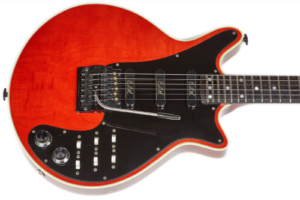
I’ve managed to procure one of these interesting pieces of Brian May and Guild history, so join along while I give it the detailed review treatment right down to the magnets in the pickups.
Introduction
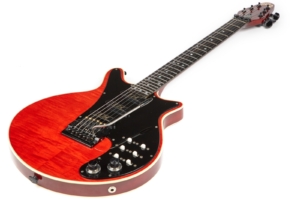
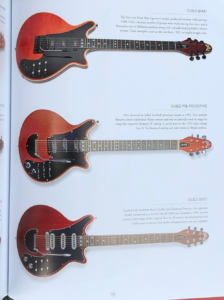
I am, as the British say, dead chuffed.
And now back to our regularly scheduled review.

Some things were accurate. The Guild guitar is chambered, has the proper headstock angle, has a zero fret, and includes a bunch of other features that they did get right, so it’s not like the guitar is a terrible instrument, but it’s not quite right for the purist.
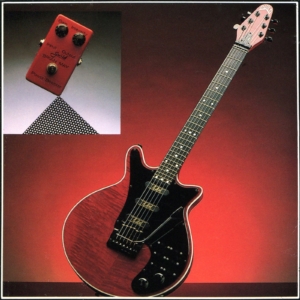
The 1986 catalog, from which this picture was taken, lists the guitar as having the option of a mahogany or flamed maple top, which guitar in the catalog and the one in this review both have. The mahogany topped versions look similar but the grain is, of course, much finer and not visible from a distance.
The pedal shown in the catalog is often said to have come with the guitar, but I’ve never seen one for sale including the pedal. The pedal is also listed in the price guides as a $100 item, so I don’t know if perhaps some dealers just packaged them together or if there was something else going on. I can tell you that in 2018 the pedal was almost as difficult to find as the guitar, but I have one that I reviewed here.
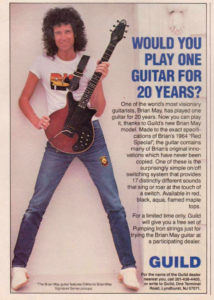
If the serial number charts are to be believed (and they shouldn’t), then there were only about 350 of these guitars made. Ron Thorn, Principle Master Builder at the Fender Custom shop, owner of Thorn Custom Guitars, and well-known collector of Guild Brian May guitars has written that he’s never seen one with a serial number below 100 and therefore thinks that there may be only 216 of them. I cannot validate either number, but even if you consider those numbers to be low by half that’s still not a lot of guitars for what amounts to the only production copy (at the time) of one of the world’s most famous guitars.
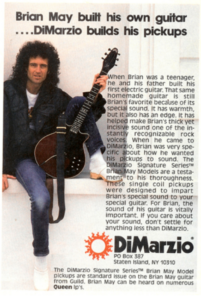
I think my favorite part of the Dimarzio ad is the bottom where it says, “Brian May can be heard on numerous Queen LPs.” You know you’ve made a lot of records when they stop listing your latest one and just say, “look, there’s a lot of albums so just go ahead and pick one because there’s not a loser in the bunch.” Dimarzio sold those pickups individually as well and I sometimes see them listed online for similarly ridiculous prices. As you’ll see, I went and bought one which I examine below.
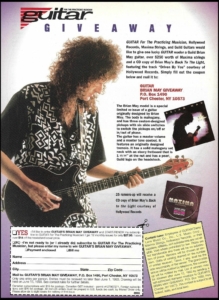
By the way, if you’d like to see some pretty cool custom or one-off Guild Brian May guitars from the 1980s, it’s worth checking out Abalone Vintage’s page to that effect including this killer black one and this knock-out sunburst example. And if those don’t wow you, how about this seafoam green example from this page
Back to the history of this cool guitar, as much as people these days complain that the 1980s Brian May BHM1 isn’t good enough, it was clearly good enough for Brian May who proceeded to use it in the 1985 One Vision video. He’s even wearing a very ’80s Guild neon logo tank top in some of the scenes! That logo was used on many electric guitars from that era such as this one from the Setzer Bluesbird.

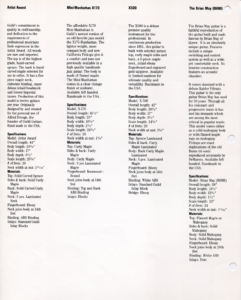
The 1986 catalog includes the detailed description shown here, and notes a bunch of marketing hyperbole about it being an absolute unique guitar, though I think there’s a little bit of wordplay there since they’re describing Brian’s Red Special while shifting back and forth to the Guild.
Though this catalog doesn’t list color options, the pics I linked to earlier clearly indicate that if colors other than red weren’t standard, then they certainly were available as a custom option because there are a fair number of spectacular looking non-standard examples of this guitar out there and I have to admit that I kind of want to own them all.
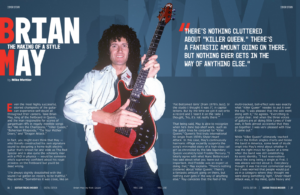
The case
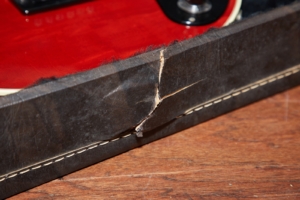
Finish
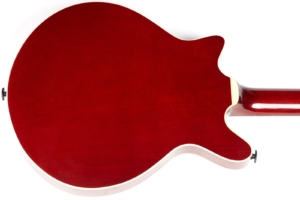
Fretboard and Neck
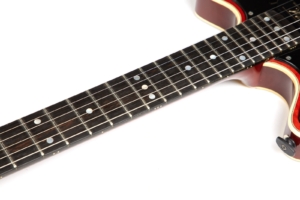
My guess is that a super-huge neck would have been a tough sell in the midst of the shredder-crazed ’80s, but then this guitar didn’t sell well in the end, anyway, so I guess the change didn’t pay off.
This is a 24″ scale instrument which is supposedly part of the magic since most Gibson and Guild electrics are 24.75″ and most Fenders are 25.5″, so 24″ is an odd size. The fretboard is unbound ebony which is nice and I might argue an upgrade from the original which has an oak fretboard that had been coated with Rustin’s black plastic coating to make it look like ebony because they couldn’t afford the real thing at the time. The carve is right around 9.5″ which is similar to the original.
The inlays on the original were buttons from his mom’s (mum’s in the Queen’s English) sewing kit, but I’m going to go ahead and assume these are typical pearloid dots. The inlay pattern which is fairly unique matches the original guitar.
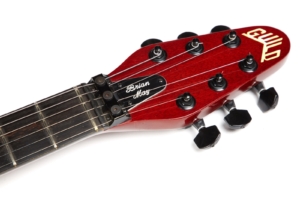
One of the changes from the original is the addition of the locking nut which is part of what you get when you add a Kahler. Brian’s Red Special now has Schaller locking tuners on it, but it has never had a locking nut. This guitar has a zero fret just like the original.
Another important design aspect of the original that is matched in this guitar is the headstock angle which is very slight at only 10 degrees. This makes the strings a fair bit slinkier than on other guitars with more severe angles, though I’d venture a guess that that’s tempered a bit with the addition of the locking nut. It definitely adds to the overall look of the guitar, though, especially given the shape of the headstock.
Build Quality
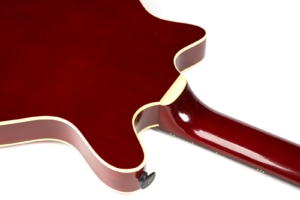
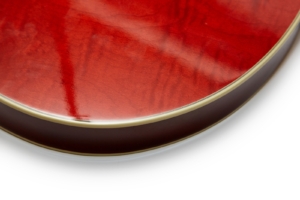
complaints about this guitar to be that it’s not chambered like the original even though it says in the catalog that, Its interior construction includes an acoustic chamber. I should also point out that the very same catalog then describes the body as solid mahogany, so without a bandsaw or an x-ray machine I can’t say for sure.
Further fuel for the “it’s not chambered” fire may source from the Wikipedia article on Brian May where it says, In 1984 Guild released the first official Red Special replica for mass production, and made some prototypes specifically for May. However the solid body construction (the original RS has hollow cavities in the body) and the pick-ups (DiMarzio) that were not an exact replica of the Burns TriSonic did not make May happy, so the production stopped after just 300 guitars.
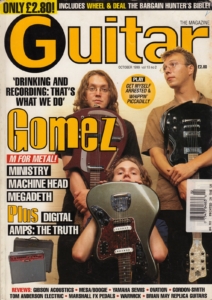
There’s no way for me to tell if this guitar is chambered short of someone volunteering to x-ray it for me. Rapping on the back with my knuckle reveals nothing. I can tell you that my 1990s Guild Brian May BHM1 weighs 8lbs 2oz – a full pound heavier than this one, and that’s the one that people say is better because it’s chambered.
Pickups
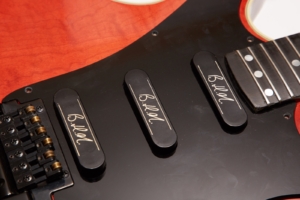
Although I did not measure the pickups in my guitar directly, examples that I’ve found online all measure in the 8.0-8.2k DCR range, an example of which is shown in this Worthpoint link. I did buy a single additional example of a DP206 that I paid way too much money for just so that I could tear it apart and compare it to the Trisonics. Such is the depth of my madness. Before we get to that, though, let’s talk about the original Trisonics in Brian May’s Red Special guitar.
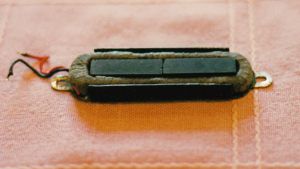
The patent (3,249,677) for guitar pickups from Burns shows the design of the original Trisonic and the text for the patent states that there can be one or two magnets, though as seen in the picture of the original Red Special pickup and the modern Burns version, most of the examples that I’ve seen have two magnets. Additionally, these pickups are bobbin-less and the patent goes on to state that …it is not essential for the coils to be wound on bobbins and they can satisfactorily be constructed either by winding them of enamel copper wire and shaping them on a former and then coating them with a lacquer such as shellac.
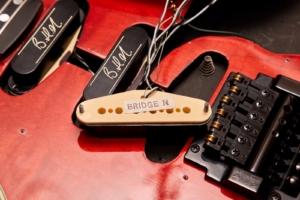
Can you tell me anything about how the Dimarzio Brian May DP206 pickups from the 1980s (for Guild) were constructed? Are they like Strat single coils or are they built like the original TriSonics with the wire wrapped around the magnet? (email – Jan 26, 2019)
And their response:
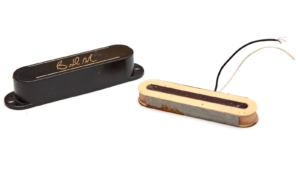
I decided to procure a spare while I was waiting for Dimarzio’s reply so that I could dismantle it to see what’s inside. You know, for science. And yes, I got in a lot of trouble for taking things apart when I was a kid.
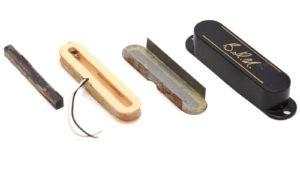
The magnet from this pickup is most definitely ceramic which can be determined based on its dark color. In this pic I’ve placed the Dimarzio Brian May magnet between two humbucker magnets to show the color difference. The two humbucker magnets are Alnico II and Alnico V, both of which kind of look like steel, while the ceramic magnet in the middle is quite obviously black.
One of the drawbacks of using ceramic magnets is that ceramic is brittle, and the magnet from the pickup I took apart actually had a chip broken off of one corner which was suspended in the dried out goo where the magnet was. Remember – all I did was push this magnet out with my fingers. There were no tools involved, so it’s not like I abused the pickup to get it apart.
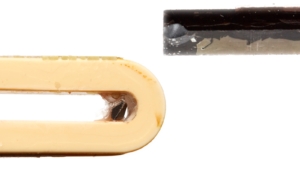
Brian May solved the squealing problem in the ’60s by potting his pickups, though he used Araldite epoxy instead of the wax we would generally use today. He also only did this on the neck and bridge pickup, and from what I’ve read he does not recall why he did not include the middle pickup in this process. You can read about this in Brian’s own words on the Burns website.
Electronics
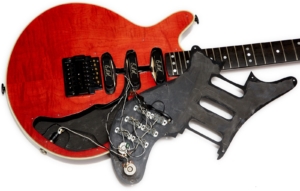
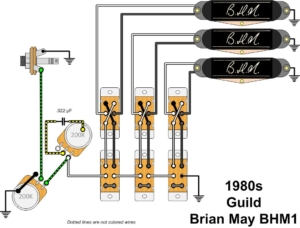
While I’ve complained a bit about the pickups, a huge part of the magic in the original is this unique wiring scheme, and the Guild pretty much nails it. What I must confess to not liking about the guitar’s electronics is the messy wiring.
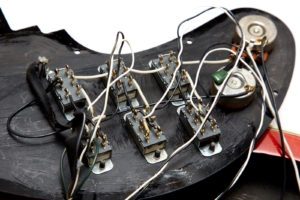
To be fair, this is not the kind of thing that really affects the sound or playability, but it’s always better to have clean wiring. Always. This is something that Guild got right on the 1990s Brian May guitar, so stay tuned for that review where you’ll be able to see for yourself. This is possibly due to the fact that Guild was owned by Avnet in the ’80s and US Music in the ’90s, but that’s speculation on my part. It could just be that they hired a new wiring guy.
Once of the things I have to say that really bugged me about the wiring was this big ugly ground knot. That’s not a real technical term, by the way, but just look at that and tell me it’s not a ground knot.
It looks to me like someone twisted all the ground wires in the guitar together, heated it up and plopped some solder on it. Sure, that’s another thing that doesn’t really matter and the average guitarist would never see it, but this just doesn’t look like the kind of workmanship I’d expect to see in what was the second highest-priced guitar sold by Guild in 1985. Especially a guitar with Brian May’s name on it.
With either of the outer two pickups selected with the middle pickup and both in-phase, the combination is hum cancelling which tells me that the the middle pickup must be Reverse-Wound and Reverse Polarity (RWRP) which is something that Brian May and his dad also did so many decades before the general guitar population started doing it with single coil pickups.
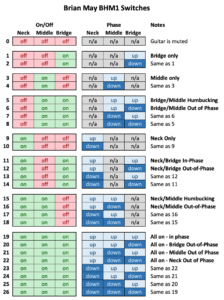
Brian May discusses how the pickup switches all work in this very cool YouTube video from his Star Licks recording from the ’80s. He even mentions Guild and this model guitar and then mentions how it would be great to have a copy because he’s been playing his beloved Red Special for 20 years. Remember, this video (as of this writing) is 34 years old and that guitar already looks pretty well worn-in so you can imagine how it looks now.
Hardware
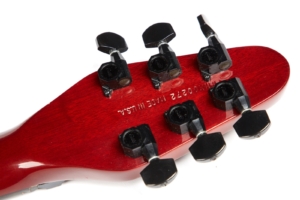
The tuners on the ’80s Guild Brian May guitar are the standard tuners that came on pretty much all of the Guild electrics around this time and they’re good, tight, and tune reasonably well, probably since they’re made by Gotoh for Guild. They just don’t belong on this guitar. This looks like a sure, we’ll make a signature guitar so long as we can use parts off the shelf for it kind of move to me, which brings me to my next big gripe, and it was a deal-breaker for a lot of people.
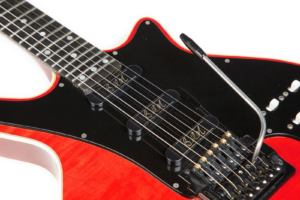
Now, as a hard-core Floyd Rose fanboy from the ’80s, I used to hate Kahlers, but as I’ve collected and played many Guilds from that era I’ve come to appreciate some of its design aspects so I don’t outright hate them any more. Except on this guitar. Holy hell does it just ruin the look of this guitar.
Remember what I said about using off-the-shelf parts on a signature guitar? Here we go again. I guess we should be glad it wasn’t a Floyd Rose because Guild has a history of totally getting those wrong. Hey, the Kayler (a 2300 pro) is completely functional and performs as it should, but it looks like a big old ’80s dad fanny pack on a supermodel in an evening gown.
It looks like someone took the blower from the car in Mad Max and cut a hole in the hood of their classic Austin Martin to make it fit.
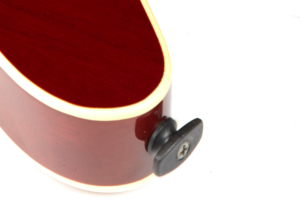
It looks like crap.
OK… I’m done. Suffice to say, I think the Kahler was a bad move
The pick guard is one-ply like the original which is something that the ’90s model got wrong. The strap pegs are the same type used on Guild Nightbird guitars from the early 1990s which are these Gripper Strap Buttons that can be found on StewMac. They do hold the strap better than the old-fashioned pegs, but they’re a pain in the butt to get the strap on and off of, so I’d probably convert them to strap locks if I were to gig with this guitar.
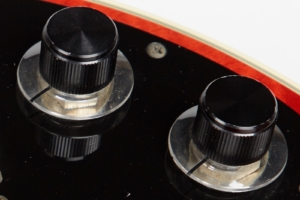
First, these knobs are much grippier and easier to grab when sweaty. Second, the design looks very similar to the originals, though the skirts on these are clear plastic that has a single marker line on them. I think these are not so horrible a change as the Kahler, which I may have mentioned that I didn’t like, but the bottom line is that this is a signature guitar and so it should look, play, and behave like the real thing. To be completely fair, the glut of signature guitars didn’t really take off until the late ’80s, so this guitar was something new.
Sound
When I sat to record this guitar, I had just come from a week of playing only the 1990s Guild Brian May guitar due to my having used that for my Guild Brian May Treble Booster pedal article. For better or worse, that became my standard for how a Red Special clone should sound and behave.
I’d read a lot of stuff online about how the 1990s Guild was much better than the 1980s version, but I try to go into these things with an open mind and so, without even thinking, I picked up the ’80s Guild and plugged in. Did it hold up to the ’90s Guild? No, not really.
As usual, for these recordings I used my normal Axe-FX III setup through the QSC K12 speaker recorded direct into my Macbook Pro using Audacity. I recorded using the ODS100 Clean patch, and then I recorded using an included Bohemian Rhapsody patch but with the included cocked wah disabled because that altered almost every setting to sound the same (which actually works nicely with a humbucker guitar).
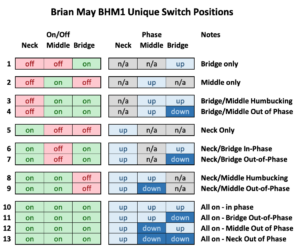
This section is about sound, and playability is in the next section, but I can tell you that when it comes to tone, it’s not even close to the real thing and for that I mostly blame the pickups. The guitar just doesn’t sound like classic Queen. Sure it can sound nasally and thin because the pickups are wired like the real thing, but they’re not Burns Trisonics, they don’t behave like Burns Trisonics, and most importantly they just don’t sound right. If you listen to the recording and think that it’s not bad, that is almost 100% the Axe-FX’s doing.
ODS100 Clean Chords
BR Preset Riff
My first impression while playing this guitar after a week with the ’90s Guild is that this guitar is strident and harsh when two pickups are selected and put out of phase. With the ’90s Brian May Guild I was constantly inspired to learn more riffs or dial in an extra 1% of Brian’s original tone. With this guitar my first thoughts were, “what’s wrong?” followed by about an hour of experimentation which resulted in me blaming the pickups. With two pickups on and in phase, the guitar often overdrove whatever amp I used and usually unpleasantly at that.
One Vision
I will say that I did not hate this guitar, but it did frustrate me trying to nail Brian May tones, and I think I figured out that with my rig set for the ’90s Guild, the ’80s Guild didn’t work well. Now, with my rig set for a “regular” guitar, this ’80s Guild did much better, so I think with the right setup you can still get there.
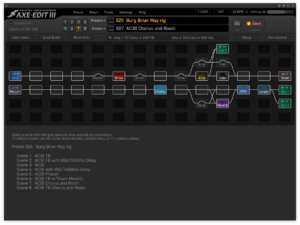
Also, you know what? I think that One Vision recording sounds pretty damn good (here’s the original to compare it to) so suddenly with the right signal path this guitar’s got a lot more going for it than I thought. I still find some of the settings to be pretty harsh, but with the right rig I think this guitar can sing. I can tell you that I tried the same preset with a humbucker guitar and it sounded absolutely awful, so the guitar can’t be discounted in that recording.
Playability
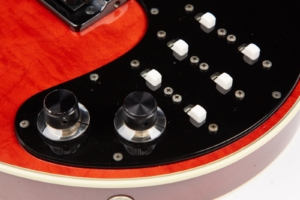
Standing is a different matter and the guitar hangs very well. Quick changing the sounds can be a little bit of a challenge since there are so many switches, but I’d imagine that’s something you’d either get used to or work to avoid having to do mid-song. The knobs are easy to manipulate and though there’s a line on the knobs skirts, those skirts are transparent and are over a black background so they’re not too easy to discern in the dark. Still, I tend to adjust knobs by feel and sound, anyway, so that’s not really a big deal.
The fretboard is very wide at 1 7/8″, so if you’re not used to that it can feel a bit odd, but as someone with large hands, I love all of the room the wide neck affords me. The neck is kind of shallow for the width, and I personally found it a bit too thin for my tastes. Apparently the real Red Special’s neck is 1 1/8 inches (29mm) deep at the nut which is deeper than any Historic Les Paul I’ve ever played by almost 1/4 inch. That’s a BIG neck. I think somewhere between those two extremes would have been good.
Conclusion
When this guitar came out there was nothing else like it available to the regular consumer. Sadly, it didn’t really measure up and has become mostly a collector’s piece. With the prices these things are getting on the used market, the average musician would be much better served buying a modern Brian May guitar from the man himself. Sure, those are made in Korea and this is a US-made guitar, but this guitar can’t be warrantied and as a collector piece probably shouldn’t be played out much, anyway.
Let’s say you’re someone like me who has more money than brains and you want the real deal US-made Guild. I’d still not recommend this one because the Guild Brian May guitar from the 1990s is just that much better in almost every way. Watch for my review of that guitar. However – and this is a big one – I got this guitar for almost half what I paid for the ’90s version. That’s still a sizable pile of shells, but we’re talking fractions of thousands, so it’s not a distinction to be taken lightly.
If I were to gig with this guitar instead of worrying about it getting dinged, I’d probably opt for a set of Burns Mini Trisonic pickups to see if they could closer to that killer Brian May tone while also imparting just a bit more authenticity to the look of the guitar.
Is this a bad guitar? No. In fact, it’s really quite a nice guitar. It’s just that it was sold as a Brian May signature guitar and to that end I feel that it falls short. I’ve harped on the Kahler and the pickups and a whole bunch of other stuff, but when it comes right down to it, can I make this guitar sound like Queen? Yes, especially today where I’ve got a supercomputer of a guitar processor (the Axe-FX III) that can let me dial in almost anything I want. Sure, that’s easier to do with my ’90s Guild BHM1, but is this was the only Brian May guitar I had then I’d have no problem playing it on stage where the nit-picky collectors wouldn’t be watching. I’d just be afraid of knocking it around because it was so expensive, and by “expensive”, I mean half the price of the ’90s Guild Brian May guitar. Still, for a US-made Guild that’s impeccably built and hard to come by, the price may not be too bad. That is, if you can find one.
Donate: PayPal Crypto:
ETH: 0x0AC57f8e0A49dc06Ed4f7926d169342ec4FCd461
Doge: DFWpLqMr6QF67t4wRzvTtNd8UDwjGTQBGs


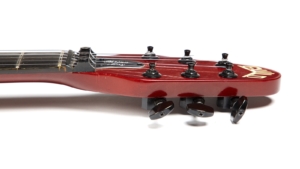
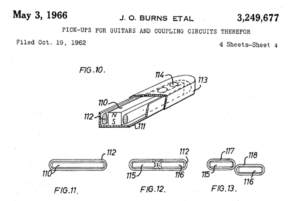
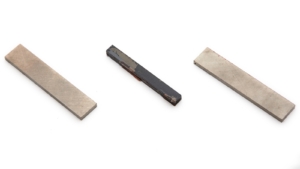
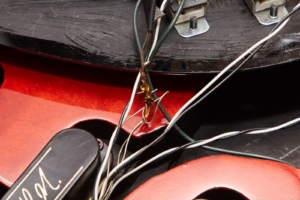
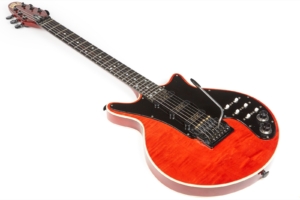
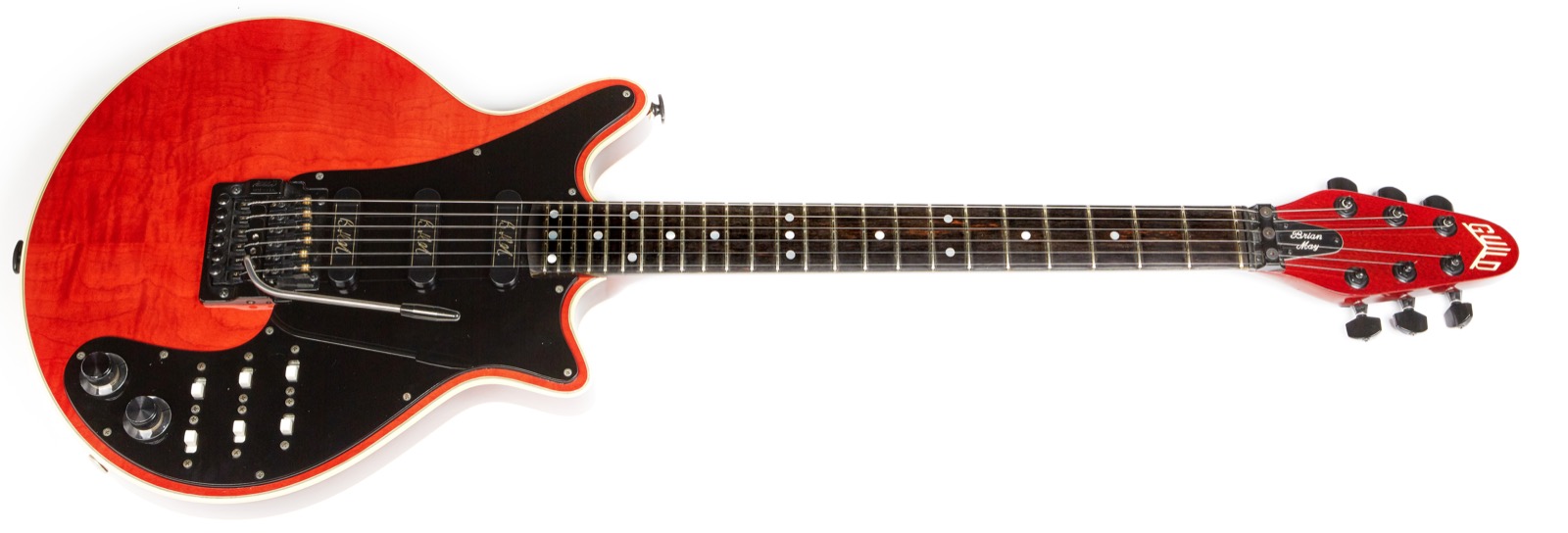
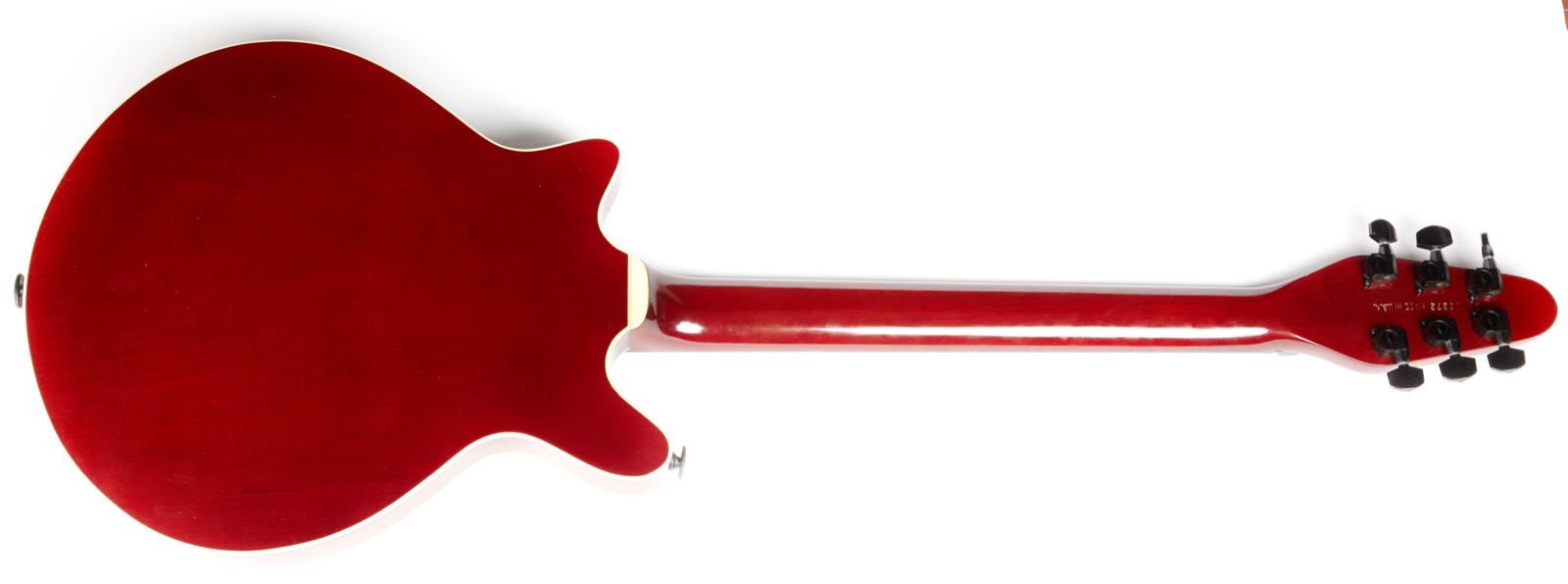
Hi…fist of all congrats for thr review on the Guild BHM1…I recently bought bridge and middle pickup Di Marzio BHM DP206.
Unfortunately I cannot find the same pickup for neck position (so called DP206N). I would like to know If I can install an additional bridge or middle DP206 BHM pickup (depends on what I will find) in place of the neck pickup, since the output is almost the same (ranging from 8.0 to 8.2 kohm). In your opinion will this drastically affect the sound or this could be a negligible variation?
Thanks for your reply.
Regards from Italy
If memory serves the middle is reverse wound and reverse polarity which makes it hum-bucking when paired with either the neck or bridge, so I would think it would be the middle pickup that’s different. In other words, if you’re looking to replace the neck and can’t find a neck pickup, I’d look for a bridge pickup to do so.
If you put a middle in the neck position it will work and you can always reverse the winding by wiring it backwards to get the phase right, but it may not be as quiet in the neck/middle position.
Hi… Finally I am coming back since I am facing a doubt with installation of di marzio pickups on my BMG… I am replacing the Korean made tri sonic!…in order to do this I am strictly following the wires as shown in the picture of your pickguard… Then I noticed that the wiring scheme seems to be not consistent with the picture. In other words white and black color cables of the pickups in the wiring scheme seem reverse with respect to the picture of pickguard. It is just schematic or there is something wrong? … I am following the picture of the pickguard since it sounds to me more logic!.. Thanks in advance for your help!
Hey there! The pic of the wires is upside down in relation to the drawing. Look at the position of the knobs – you’d have to flip the pick guard around to get it into the same orientation. Does that help?
Brian’s neck pickup is different to the other two in that it doesn’t have a base plate. This changes the inductance and resonant peak to be more “0pen” and Strat like.
If you want a neck pickup to sound like Brian’s and play well with your bridge and middle? I’d go for a light blue Lace Sensor
Michele,
There was NO “real” neck pickup; it was a repackaged bridge pickup. The middle pickup was indeed the reverse wound pickup. So, on the BHM-1 guitars the the Bridge and Neck are the same and the Middle is the odd man.
Hi, I have an early (low serial) of these. Can you tell me how much you paid for yours. I may be looking to sell or swap mine for a more modern high end replica.
Thanks
I sent you an email with my reply.
Hi Barry, I’ll be interested in the Guild, I have a few top end Brian May guitars.
Gad,
You have most everything correct in your article. Here are some details you might be interested in:
The headstock is completely inaccurate to the shape of the original. Incidentally, it was the John Birch copy seen in the We Will Rock You and Spread Your Wings promo videos that Guild used as a stand in for the original. I believe it was this first deviation and a second subsequent deviation, to make proper width for the locking nut, which ultimately gave the headstock its different shape. There is a long and interesting story about the John Birch copy which “disappeared” for decades that I had a small role in seeing returned back to Brian May. An old Brian May guitar enthusiast friend of mine did all the real work!
There were numerous prototypes, only three of the later ones Brian May actually used or was ever seen with. The easiest way to identify them in photos/videos is: At least one has a black headstock front face (One Vision Video… and sorry no, it was NOT used on the actual record) and one other has differently shaped pickguard (Freddie Mercury Tribute Concert during Hammer to Fall). Additionally, if you look close at the prototypes in the above images of Brian May, you will notice that, like the original, the switches are mounted to plate under the pickguard, there are no screws holding them onto the pickguard itself. Lastly, Brian May was no fan of the locking nut and had them removed before putting them to use regularly. The only way to effectively do this is to open up the nut slots a significant amount. Just like the original, the nut does not act as an anchor point, it is only a “string guide”, and the strings don’t actually make contact with the nut at the bottom at all.
NONE of the BHM-1s (1984-1986) were ever routed for an acoustic chamber.
I believe that you and Ron Thorn are correct and that the serial numbers start at, or very close to, BHM00100 and end at, or very close to BHM00316. Making them a hundred or so fewer than the long held belief of approximately 300 made.
Only early versions were sent out with the treble boosters which were all handmade, including the circuit board, which was purportedly nearly identical to the Pete Cornish unit that Brian May was using at the time. I think the rumor was that there was a threat of a lawsuit and the boosters very quickly, “went away”… despite the fact that the Guild unit had a master volume and gain control!
The early versions (of which I own one), came with a “swimming pool” routing in the body and the pickups were attached to the pickguard and were height adjustable. They had Grover tuning machines which I do find look better than the later Guild branded machines and regular old strap buttons. Some had white switches, some had black. The pickups, early on, did NOT have the BHM initials, they were simply plain black covers. The internal structure of the pickups were, as you mentioned, simply glued together… and very lightly so, at that. They were very micro-phonic, particularly after the brittle glue aged and cracked.By the way, try potting them in wax and you will be pleasantly surprised.
Later versions (of which yours is one) had the optional maple top (plain, flame, quilted or birdseye) and the non-maple versions were not “topped”, they are simply a slab of mahogany. The pickups were mounted to the body in individual routes and are not really height adjustable. The gold colored scripted initials on the pickup covers are actually replications of Brian May’s own writing. Many years ago, I sent my early-non-initialed pickups to Dimarzio and had them wax potted and the initials added to the tops.
If memory serves me correctly, all the available colors for the maple tops included: cherry red stain, turquoise stain (some look true blue), amber stain, black stain, cherry sunburst stain. I believe the mahogany slab guitars were all cherry red. There are also black painted and seafoam green painted versions but who knows if they are full mahogany or maple topped.
Incidentally, I am personally aware of one of the cherry sunbursts having been professionally refinished in red by an owner, again, if memory serves me correct. About 20 years ago, I told the guy how rare the sunburst variant was and he proceeded to kick himself for having had it done. I think the rarest color is the charcoal black variant, of which, I only know of one.
I am fairly confident that only the maple top guitars featured multi-ply binding. The standard mahogany slabs featured single ply white but this also could have been a case by case detail or another early/later change.
Lastly, I would almost guarantee that someone has fiddled with your guitar under the pickguard before it got to you. Of course I could never say definitively but that does not look like all Guild’s work for a number of reasons.
Thanks. What is your source for all of this information?
About 20-22 years ago I created and maintained a web site called, “Jackfunk’s Brian May Web Site”. The Jackfunk name was an old Internet pseudonym of mine… it’s a long story unto itself.
Anyhow, apparently, at the time, my website got to being pretty popular around the world and I guess it kind of set the trend for information about the guitar at the time. This was around 1997 or 1998 just prior to Brian May’s new album came out AND all the information made trickling available by Greg Fryer whom had built three replicas of the original which led to Brian May asking him to do some much needed refurbishments on the original as well. In fact, Brian May finished recording Another World with two of Fryer’s replicas while Fryer himself made the repairs to the original.
Anyhow, I made some close friendships with some key people around the world thanks to the web site AND they respected my ability to keep my mouth shut by not publishing everything they shared with me if requested not to do so. You can’t believe how careful and secretive the Brian May camp was at that point in time; I am sure there were some decent reasons and perhaps some not so! Contacts and friends galore from elements of the Brian May guitar camp, former Guild employees, Burns of London/USA employees, companies that made or were making unofficial copies, individuals, fans, etc… at the time it was a “Secret Clubhouse” that you almost had to be vetted into slowly and fortunately, I guess my web site idea was a part of the whole thing.
So for several years I was kind of plugged into guitar information from every possible angle from around the world. I was, additionally, very interested in searching out all information that I could find and I had, at the time, a pretty extensive collection of magazines and articles that covered the guitar and/or its copies from the past 20-30 years of its life. It was my intention to expand the web site into something very polished and professional looking; the existing site wasn’t bad looking but I really wanted it to look more professional. I purchased the domain Redspecial.net and began some tests and ideas that I ultimately lost interest in, mostly due to…. LIFE happening!
After a while, I picked a close colleague to act as the contact for the way the original site was at the time and I walked away from all of it. The hosting service had been pre-paid for a few years so it aged and slowly lost relevance due to the surge in message boards and generally, more and more information coming out on the guitar(s) through magazines and what not.
So that’s the long version of a much longer version but that’s why and how I know quite a bit about the Guild guitars, particularly the 1980s Guild version… because I’ve seen more than a few AND it’s my favorite!
By the way, I really enjoyed your articles on both the guitar here and the treble boosters! I don’t think I mentioned that.
Now that’s some cool stuff! Thanks for posting and thanks for being a pioneer!
Oh yeah, incidentally… I was the one that scanned the original versions of several of those photos you have up there! 🙂
DUSTIN, you’re wrong about this: “”NONE of the BHM-1s (1984-1986) were ever routed for an acoustic chamber. I have BHM-1 with acoustic chamber and also I know a couple of people who also own such BHM’s from first replica era. This is confirmed fact from Guild and Everett Wood from RS Custom Guitars.
I have a charcoal black model so there are at least two 🙂
Hello Gary!
I’m an old friend of Dustin’s.. one of the secret society of RS’s from back in the day. I can testify to all he said or says as being BIBLE truth on our sacred guitars. I still have a few.. including the custom colors. In fact the sunburst one you showed I sold to a fella a couple years back from WAY overseas. Not sure if he still has it but he’s be a fool to sell it, that’s my belief. Good to see you still around, Dustin! I’ve barely made it thru all these years but I guess I’m a survivor or some repute. Nonetheless you are free to contact me, anybody is really, about anything QUEEN or Brian May or Guitar related. Not a problem. My FB has many pictures of my guitars and anybody is free to peruse that as well. It’s under Michael Joseph Lupariello. Anyone who views it, keep in mind, the sunburst one is no longer in my possession and I still have some not yet photographed and added to my FB. I have the white 93 prototype that was sent back to Guild for repairs back in the day while Brian was doing his BTTL tour. My vault needs an inventory update so I can’t brag with accuracy at the moment. Life has been totally getting in the way. You are all free to add me on FB as well if you wish. I will be listing a celebrity owned 85 RS this week. 1st one that’s been up on eBay in a very long time I believe. This one was signed by Brian as well as 3 others back in October 2002 when I went to Los Angeles and volunteered to help with their festivities for their Rock Walk of Fame star they got. I had 2 rehearsal days, a champagne party filled with celebs, the ceremony itself and the concert that evening where I was a helping guitar tech/roadie for the act. On the 2nd day of rehearsals Brian took the time to sign 4 of my guitars. (I shipped 6 – lol) There are pics floating around of my guitars next to his and Jamie Moses’ strat at the rehearsal studio. I think they are on my FB if nowhere else. BTW great article.. I skimmed but liked most of what I saw. I’m sure Dustin’s corrections are what maybe I would’ve added too. Thanks and all the best. Michael Kramer – PopeyeMJK@gmail.com
For an X-ray machine, try going to an animal hospital or veterinarian during a slow period. I did that here in Mass., and they shot a few photos for $45. I just showed up and told them what I wanted, and they named their price. I ended up with 3 shots of an old Epiphone Les Paul that I always suspected was chambered, based on my tapping around the body. Now I know that it has some hollows shaped like hot dogs! Sounds great acoustically, too.
Excellent read, thanks for this.
Great idea – thanks!
Have you ever watched the One Vision documentary? Brian is clearly using the red special to record and only using the Guild in the shots filmed for the video of the song.
Hey Jon,
I think the “One Vision” song was recorded with the Guild guitar, and the same goes with most of the “Kind Of Magic” album, such as A Kind Of Magic and Friends Will Be Friends. Some songs were recorded with the original, because Brian switched back, as he wasn’t happy with the sound. Some parts of Driven By You were also recorded with the Guild guitar.
Excellent analysis, thank you for posting. And great insight from Dustin, I remember the Jackfunk site from the old days. I’ve owned two and now own a Brian May Special so pretty into these things 🙂
Hello joe here, I have a bhm1 ser number bhm00224, I notice the example in this article is #00274- it’s missing one treble side tuner and the volume knob- have had no luck finding ! Can you help? Ps- the case is original guild in perfect shape , also what size wrench for the truss rod? Other that that this guitar is I played condition -thanks
You can try Hans Moust: http://www.guitarchives.nl/guitarsgalore/ or Ken Nash: http://www.theguitarmechanic.com/ for the tuners. I have never seen those knobs anywhere, though. I believe all vintage Guilds use 1/4″ truss rod wrenches, but I don’t have my Brian May nearby to verify for that specific guitar.
Appreciate this is from a while ago but I may be able to help with the knob if you’d like to get in touch
Btw, interesting article and comments, thanks
This is a really cool article – I loved reading through it and the comments too. Thanks for writing up such a detailed set of thoughts on both the guitar and pickups. I was always curious about these RS models and though they are “wrong” in so many ways, they are a great example of the thinking in the 80s, which was not really “period correct” and still pretty space age (like, “let’s keep trying new things! – hello Kahler!”).